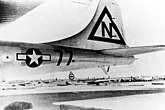Silverplate was the codename for the United States Army Air Forces' participation in the Manhattan Project during World War II. Originally the name for the aircraft modification project for the B-29 Superfortress bomber to enable it to drop an atomic weapon, Silverplate eventually came to identify the training and operational aspects of the program as well. Modifications began in November 1943 on a prototype B-29 known as the "Pullman", used for bomb flight testing at Muroc Army Air Field in California commencing in March 1944. Seventeen production Silverplate aircraft were ordered in August 1944 for 509th Composite Group training, and to allow the 216th Army Air Forces Base Unit to test bomb configurations. In February 1945, 28 more were ordered, including Bockscar (pictured), the plane that carried out the atomic bombing of Nagasaki in August 1945. A total of 65 Silverplate B-29s were made. The use of the Silverplate codename was discontinued after the war; modifications to an additional 80 aircraft continued under a new codename, Saddletree. (Full article...)
from Wikipedia featured articles feed http://ift.tt/2ahfyZo







0 commentaires:
Enregistrer un commentaire